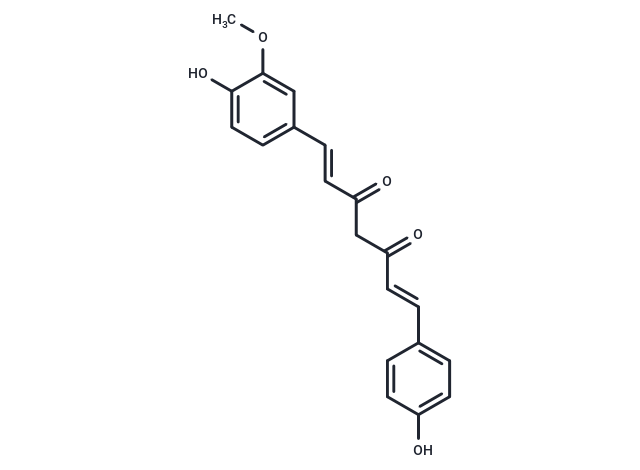Shopping Cart
Remove All Your shopping cart is currently empty
Your shopping cart is currently empty
1. Demethoxycurcumin (Desmethoxycurcumin) has antioxidant activity. 2. Demethoxycurcumin has anti-inflammatory activity. 3. Demethoxycurcumin has anti-proliferative activity. 4. Demethoxycurcumin has anti-acanthamoebic effect. 5. Demethoxycurcumin is a potential additive natural product in combination with chemotherapeutic agents in drug-resistant cancers. 6. Demethoxycurcumin inhibits energy metabolic and oncogenic signaling pathways through AMPK activation in triple-negative breast cancer cells.

| Pack Size | Price | USA Warehouse | Global Warehouse | Quantity |
|---|---|---|---|---|
| 5 mg | $37 | In Stock | In Stock | |
| 10 mg | $50 | - | In Stock | |
| 25 mg | $85 | - | In Stock | |
| 50 mg | $160 | - | In Stock | |
| 100 mg | $235 | - | In Stock | |
| 200 mg | $348 | - | In Stock | |
| 1 mL x 10 mM (in DMSO) | $50 | In Stock | In Stock |
| Description | 1. Demethoxycurcumin (Desmethoxycurcumin) has antioxidant activity. 2. Demethoxycurcumin has anti-inflammatory activity. 3. Demethoxycurcumin has anti-proliferative activity. 4. Demethoxycurcumin has anti-acanthamoebic effect. 5. Demethoxycurcumin is a potential additive natural product in combination with chemotherapeutic agents in drug-resistant cancers. 6. Demethoxycurcumin inhibits energy metabolic and oncogenic signaling pathways through AMPK activation in triple-negative breast cancer cells. |
| Targets&IC50 | BACE1:17 μM |
| Synonyms | Monodemethoxycurcumin, Desmethoxycurcumin, Curcumin II |
| Molecular Weight | 338.35 |
| Formula | C20H18O5 |
| Cas No. | 22608-11-3 |
| Smiles | COc1cc(\C=C\C(=O)CC(=O)\C=C\c2ccc(O)cc2)ccc1O |
| Relative Density. | 1.282 g/cm3 |
| Storage | Powder: -20°C for 3 years | In solvent: -80°C for 1 year | Shipping with blue ice/Shipping at ambient temperature. | |||||||||||||||||||||||||||||||||||
| Solubility Information | DMSO: 50 mg/mL (147.78 mM), Sonication is recommended. | |||||||||||||||||||||||||||||||||||
| In Vivo Formulation | 10% DMSO+40% PEG300+5% Tween 80+45% Saline: 2.5 mg/mL (7.39 mM), Sonication is recommended. Please add the solvents sequentially, clarifying the solution as much as possible before adding the next one. Dissolve by heating and/or sonication if necessary. Working solution is recommended to be prepared and used immediately. The formulation provided above is for reference purposes only. In vivo formulations may vary and should be modified based on specific experimental conditions. | |||||||||||||||||||||||||||||||||||
Solution Preparation Table | ||||||||||||||||||||||||||||||||||||
DMSO
| ||||||||||||||||||||||||||||||||||||
| Size | Quantity | Unit Price | Amount | Operation |
|---|

Copyright © 2015-2025 TargetMol Chemicals Inc. All Rights Reserved.